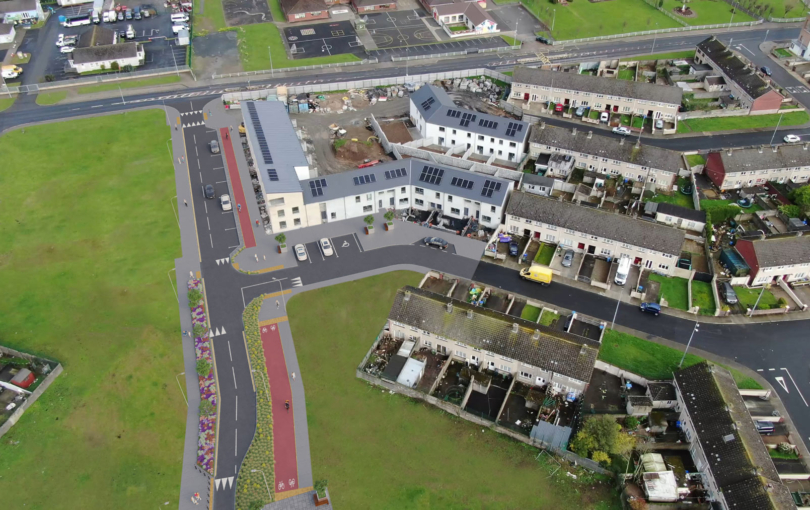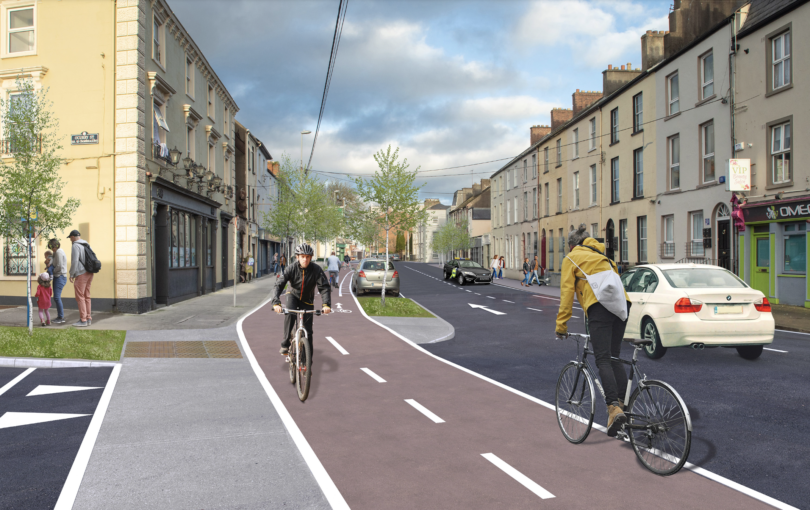Limerick Cycling Campaign welcomes the progress in bringing the TUS to City Centre to Part 8 stage and thanks the Active travel team for their efforts to date in moving the project towards completion.
As the key primary cycle and pedestrian artery into the city for Limerick City North it is essential that what is delivered is of the highest standard and prioritises pedestrians’ and cyclists’ safety and comfort while ensuring the routes are direct, coherent and attractive.
Limerick Cycling welcomes the parts of the scheme which have segregated cycle facilities and we welcome the inclusion of continuous footpaths. We have observations on certain sections that we feel need a range of alterations to bring sections of the project more closely in line with LSMATS, the Sustainable Mobility Policy and other regional and national development plans.
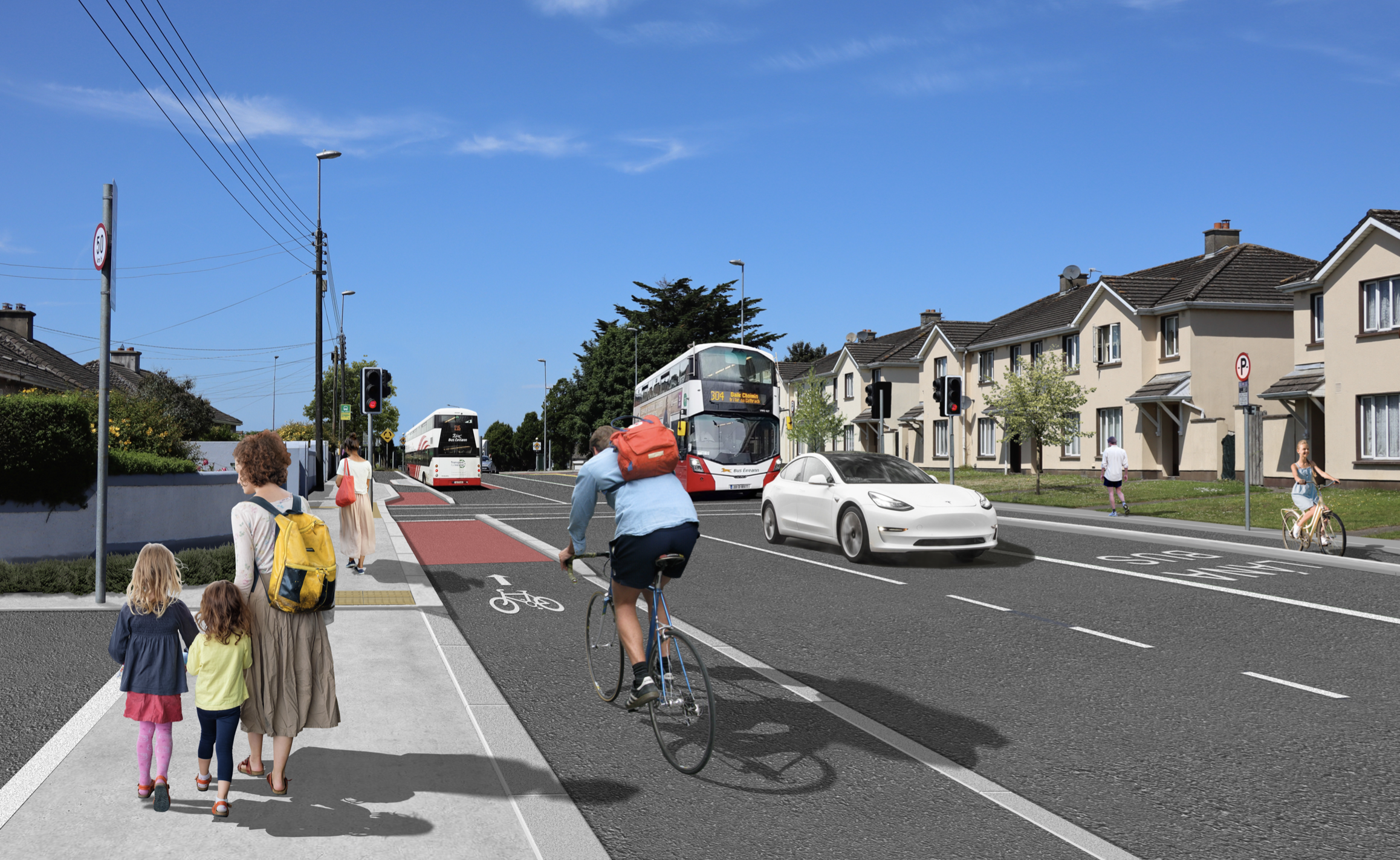
photomontage from part 8 submission
We feel that the route is unsatisfactory in so far as to be categorised as ‘TUS to the city centre’, primarily as the segregation for cyclists ends at the High Road intersection with Bellefield Gardens 1.5km away from the city resulting in this design being at odds with the name, the objective and the spirit of the project and the objectives set out in Limerick transport Strategy LSMATS.
Therefore, we urge the local authority to consider additional segregation to bring this route continuously from TUS to the city centre as part of THIS scheme (not as we have been advised as part of the Bus Connects project – pedestrian and cyclist safety are required to be prioritised above those modes).
Otherwise, the categorisation of this route should change to reflect the reality on the ground.
This scheme is seven years in the making, it is essential that now it delivers a quality and consistent sustainable transport corridor between TUS and the city centre.
We are presenting our submission under 5 main points.
1. The Failure of the scheme to provide continuous cycling infrastructure for a large section of the route significantly undermines its ability to deliver on its objectives and the objectives of LSMATS.
2. Realignment of Project Objectives required – The Scheme objectives should be realigned to correlate with the objective and targets set out in LSMATS and national policy.
3. Consideration should be given to bi-directional cycle lanes along the route as they offer a better level of service to cyclists and e-mobility.
4. A full solution should be included for the Moylish roundabout to complete the scheme.
5. Socioeconomic objectives contained in LSMATS and Design Guide and Manual for the Regeneration Areas are not given due consideration or included in the project objectives
1.The Failure of the scheme to provide continuous cycling infrastructure for a large section of the route significantly undermines its ability to deliver on its objectives and the objectives of LSMATS.
The absence of any notable cycling infrastructure on Sheet 5 (Bellefield Gardens) will significantly reduce the attractiveness of the route for cyclists, pedestrians and micro mobility. It is also at odds with the vision set out in LSMATS.
While we welcome the traffic calming measure identified for Belfield gardens this is not sufficient to enable ‘cycling for all’ along this stretch of the scheme. The prioritisation of motorised private cars over sustainable modes through Bellefield Gardens represents a significant broken link between TUS Moylish and the City Centre, this will ultimately prevent the project from meeting its objectives and the objectives set out in LSMATS.
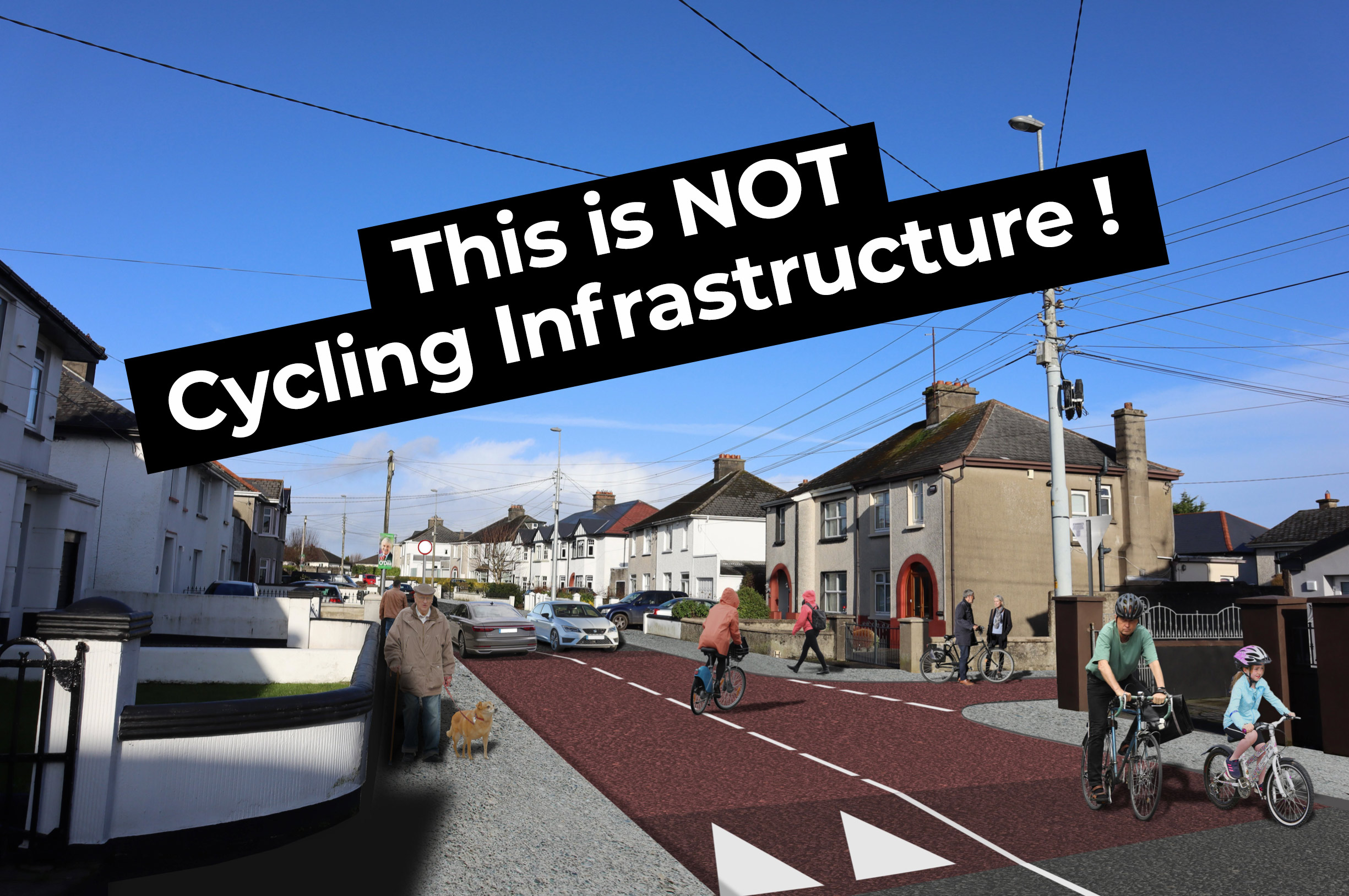
This is not cycling infrastructure – photomontage from part 8 submission
Compliance with LSMATS in relation to a continuous route.
LSMATS specifically identifies the Technological University of the Shannon (TUS) as a ‘main trip generator’ and its connection to the city as a ‘high-capacity corridor’ and ‘primary route’.
In section 9.1.2 LSMATS identifies the aim to provide continuous routes between main trip generators, TUS and the City Centre.
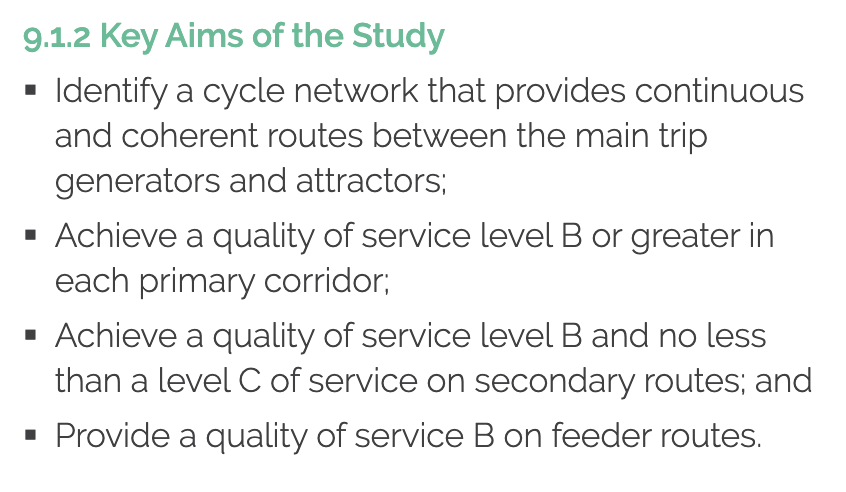
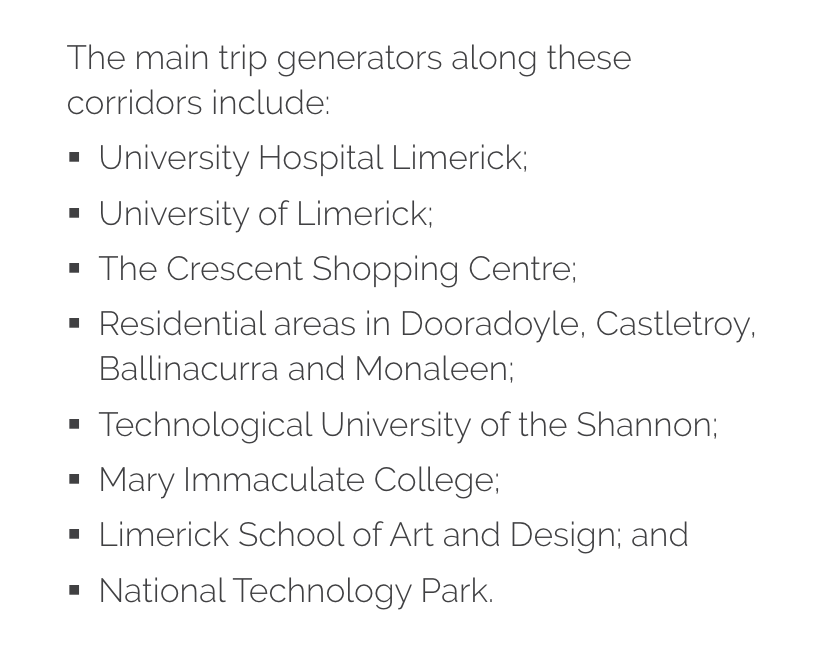
Main trip generators as identified in LSMATS
LSMATS also identifies a desired level of service for primary and secondary routes.
Quality of Service
‘Quality of Service is a measurement of the degree to which the attributes and needs of the cyclist are met. In other words, it describes the quality of the cycling environment – a high Quality of Service will better meet the 5 Needs of the Cyclist.’ (National Cycle Manual, Section 1.4)

Levels of cycle lane service
Unfortunately, the scheme will not meet the identified levels of service for primary and secondary routes due cycling infrastructure stopping 1.5km away from the city centre and side by side 1+1 not possible for the majority for the scheme.
Compliance with the national cycling manual in relation to a continuous route.
The National cycle manual is a guide for designing cycling infrastructure in Ireland. in section 7.6 it advises that “The route is as good as its weakest link.” In this case the route does not connect to the city centre without cycling with traffic on unclaimed arterial roads with cars, vans and trucks legally moving at speed up to 50km/h with many moving faster (unsafe) (not coherent as spent link origins and destinations).
The Limerick Smarter Travel Areas Ex-Post Evaluation Final Report | 2018 states “Poor perception of safety is the biggest barrier to increasing cycling” and “On-road cycling infrastructure does not encourage modal shift”.
It is disappointing that its recommendation to prioritise segregated cycling has been ignored on this scheme.
The recommendation within this document is to
“Prioritise investment in a higher standard of segregated cycling infrastructure, where possible, which is more likely to offer a higher perception of cycling safety and therefore encourage modal shift”
The Bellefield Gardens part of the scheme unfortunately does not meet any of the 5 needs of cyclists as identified in section 1.2 of the national cycle manual.
1.2.1 Road Safety
1.2.2 Coherence
1.2.3 Directness
1.2.4 Attractiveness
1.2.5 Comfort
All 5 needs are compromised due the lack of any cycling infrastructure for this large section and the prioritisation of 2-way motorised thru-traffic over segregated cycling infrastructure.
It is our suggestion that one of the following solutions be considered to enable a coherent connected route between the TUS Moylish campus and the city centre.
Ø Filtered permeability – eliminate through traffic.
Filtered permeability is an urban planning concept that “filters out” through car traffic on selected streets to create a more attractive environment for walking, cycling and community while maintaining accessibility for local inhabitants, deliveries or emergencies.
When through traffic is eliminated, it will be unnecessary to provide segregated cycling infrastructure as local traffic numbers will be significantly lower, and speeds limits are more likely to be observed.
Filtered permeability provides full access to residents while eliminating the 3,200 daily rat running thru-traffic that present an ongoing danger to the residents of Bellefield Gardens and its environs.
Effective examples of filtered permeability are already in place in Limerick City in the following locations.
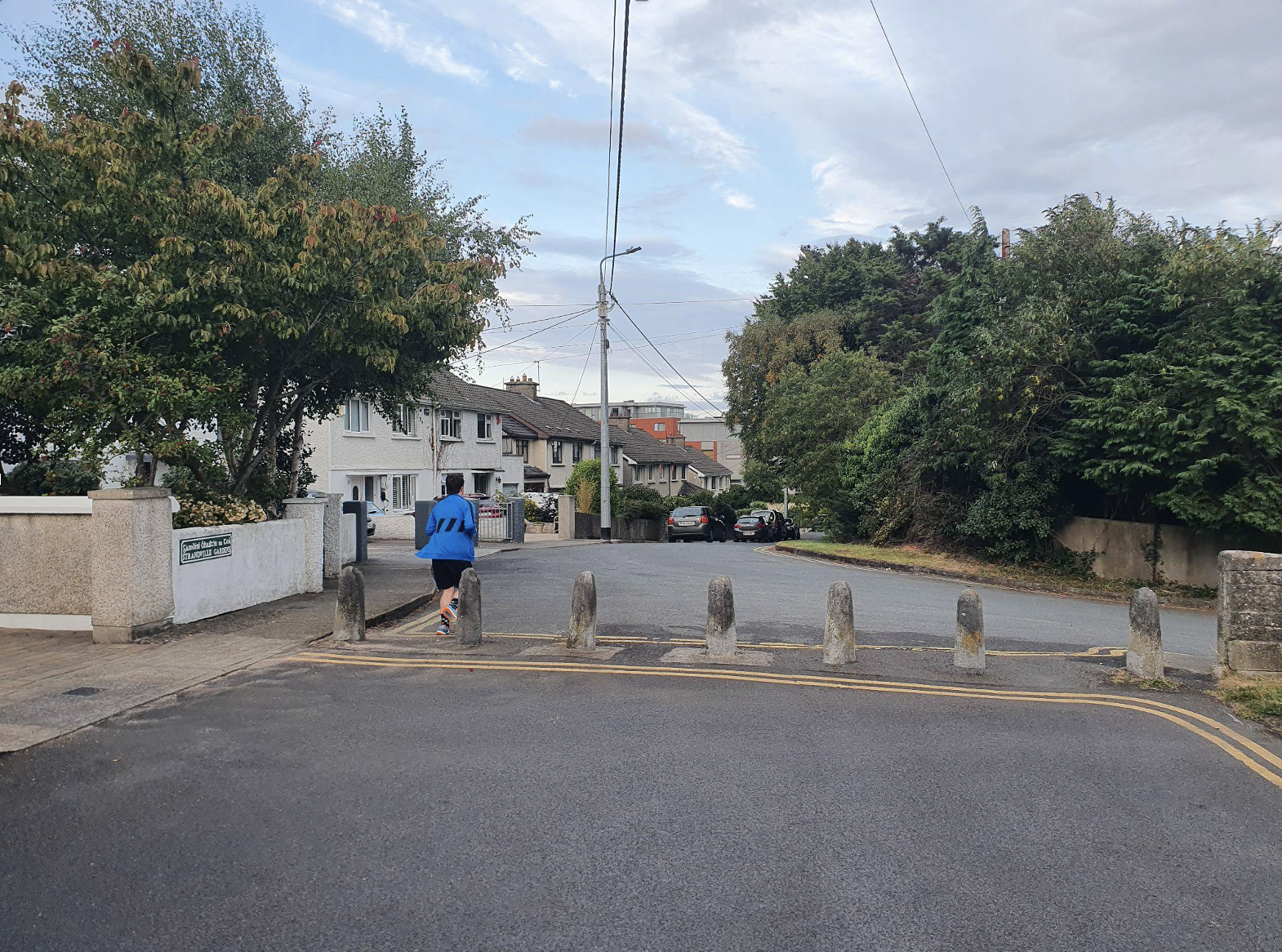 |
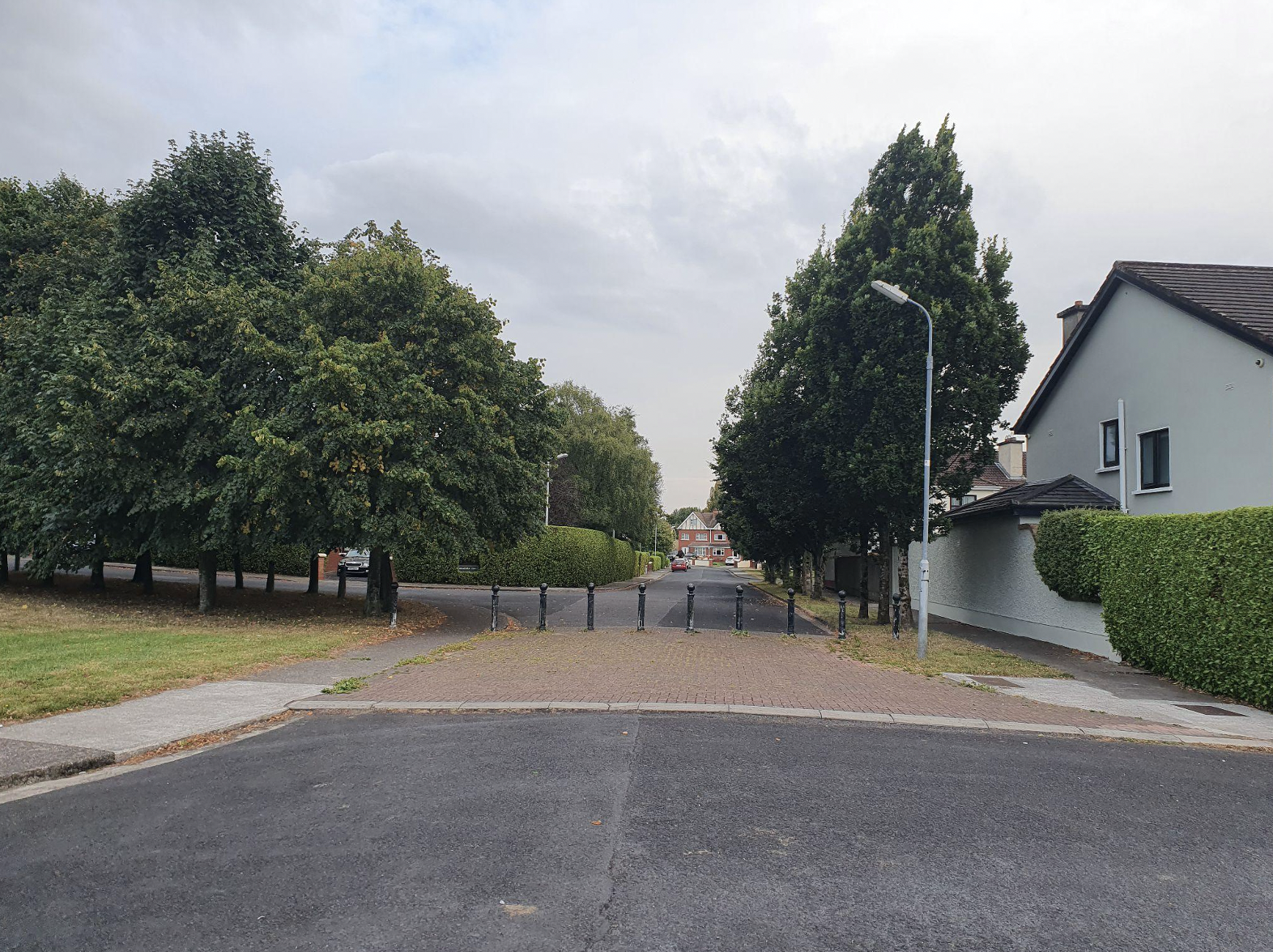 |
| Strandville Gardens and Clanmaurice Avenue
Example of filtered permeability |
Ashbrooke Gardens and Bracken Gardens
Example of filtered permeability |
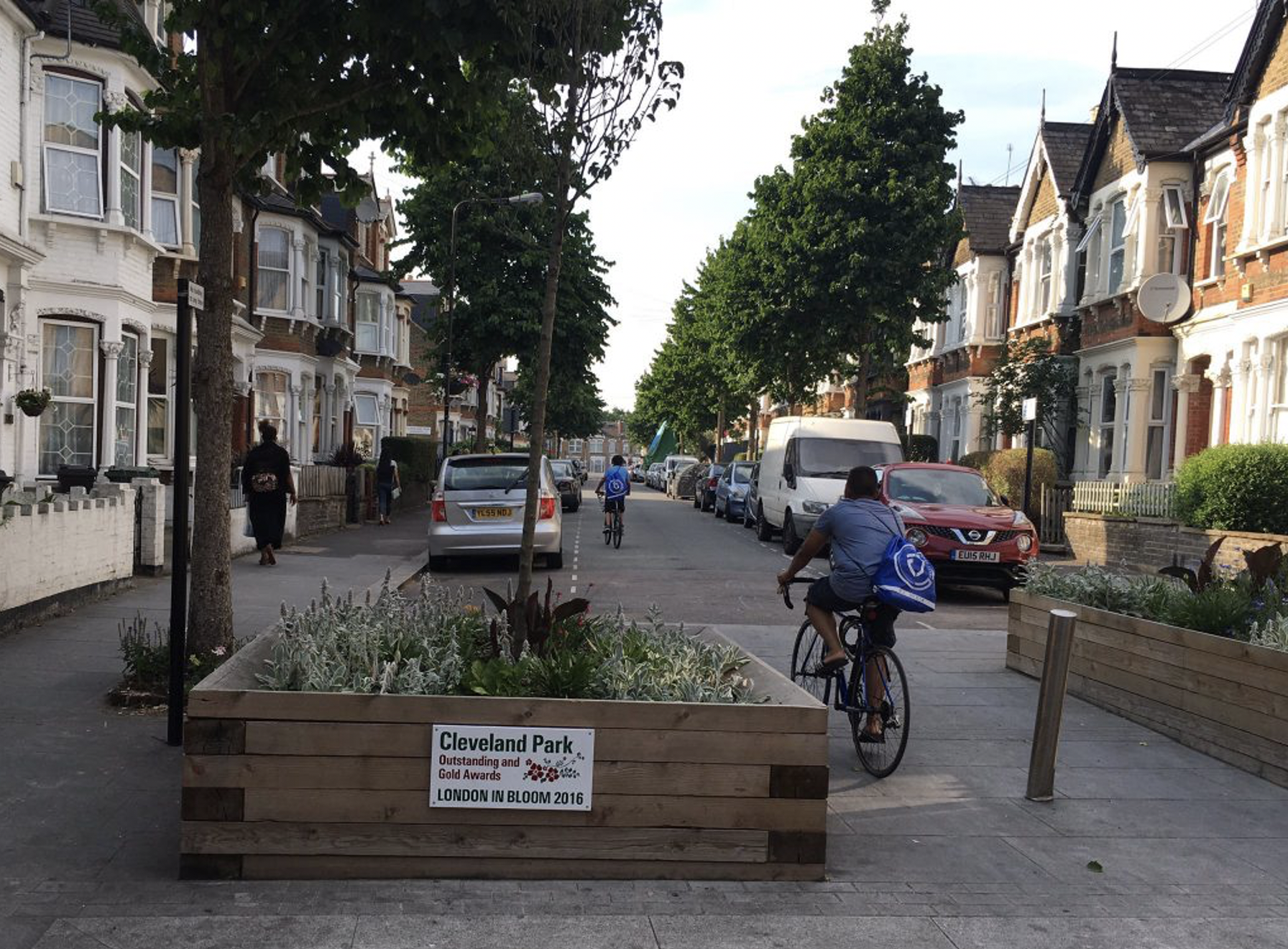
Filtered permeability from Cleveland Park London
Ø Reallocation of motor traffic space to enable a bi-directional cycle lane
Reduce motor traffic to one way one lane and install a bi-directional cycle lane from the High Road / Belfield Court junction to the Belfield Gardens / Ennis Road junction and on towards the city centre.
A bi-directional cycle lane for this section will offer a complete consistent service between TUS Moylish Campus and the City Centre.
A single lane in the outbound direction will lead to reduced rat running in the Belfield community.
2. Realignment of Project Objectives required – The Scheme objectives should be realigned to correlate with the objectives and targets set out in LSMATS.
We welcome many of the objectives identified in section 1.2 in document 1. Part 8 Planning Report, however, one of the objectives listed raises concern.
- To improve safety, comfort and security for cyclists, pedestrians and motorists;
Improving comfort for motorists in urban areas is at odds with the objectives of the funding, the objectives of LSMATS and the Objectives of the national climate action plan.
The fact that this part 8 has been prepared with the comfort of motorists as a key objective raises serious concerns about the presented scheme. It is our suggestion that project objectives be updated.
Modal Shift
In essence, ‘modal shift’ means a change from one form of transportation to another, for example, switching a car journey for a bike journey.
Due to climate national action targets and the compact nature of our city LSMATS identified the need and potential for a significant modal shift away from private cars toward sustainable and active modes (cycling, bus, walking, scooting and combinations of these).
It is widely accepted that a reallocation of space and resources from motoring to sustainable and active transport will be required to make those modes attractive enough to achieve the modal shift levels required to meet targets. It’s simply not realistic to improve the comfort for motorists and expect the modal shift identified in LSMATS and national policy to be achieved.
The modelling modal share presented in LSMATs is based on the delivery of ‘attractive connected cycling infrastructure’ and identifies a significant shift from the private car toward active and sustainable transport.
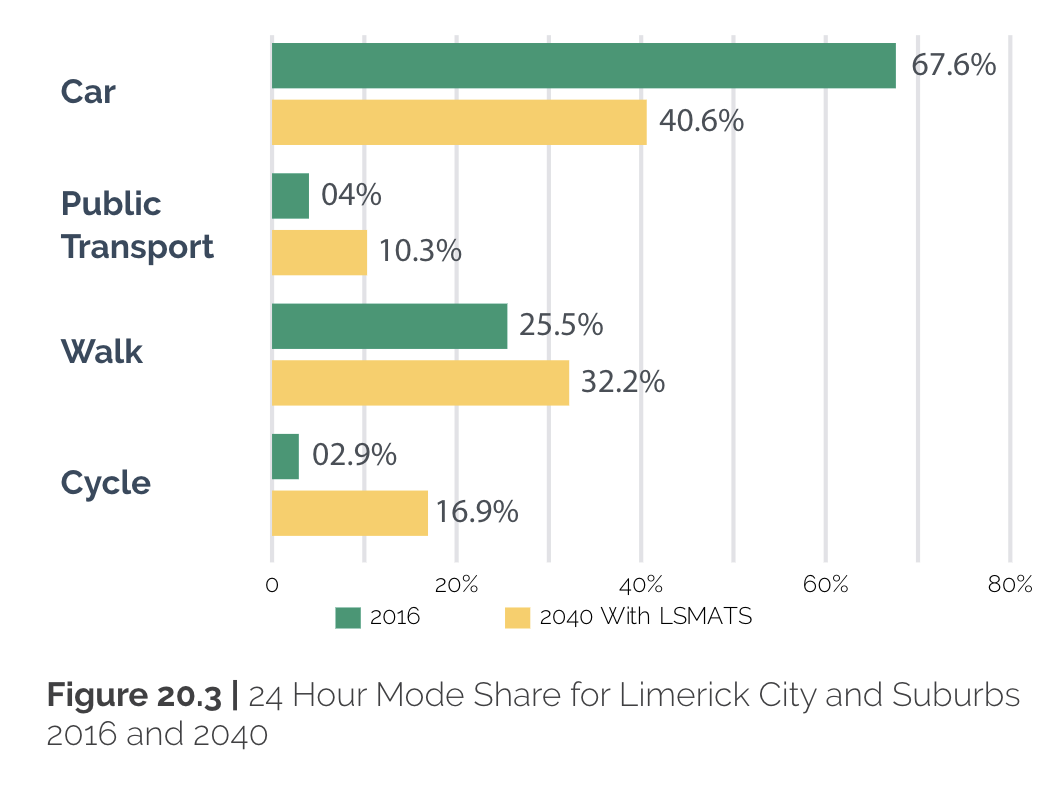
Modal Share targets from LSMATS
It is important that we design schemes to facilitate and drive this modal shift, thus it is important that we include modal goals in our objectives. Modal shift objective statements are included by other local authorities in similar Part 8 projects and they should be included here.
In LSMATS it specifically states
‘A key principle of the Strategy is to prioritise the provision of reliable and efficient public transport and enhanced walking and cycling routes to minimise the need to travel by car’
The measure of success here is the level of modal shift achieved.
LSMAT also identifies the intention to ‘reallocate road space to prioritise walking and cycling.
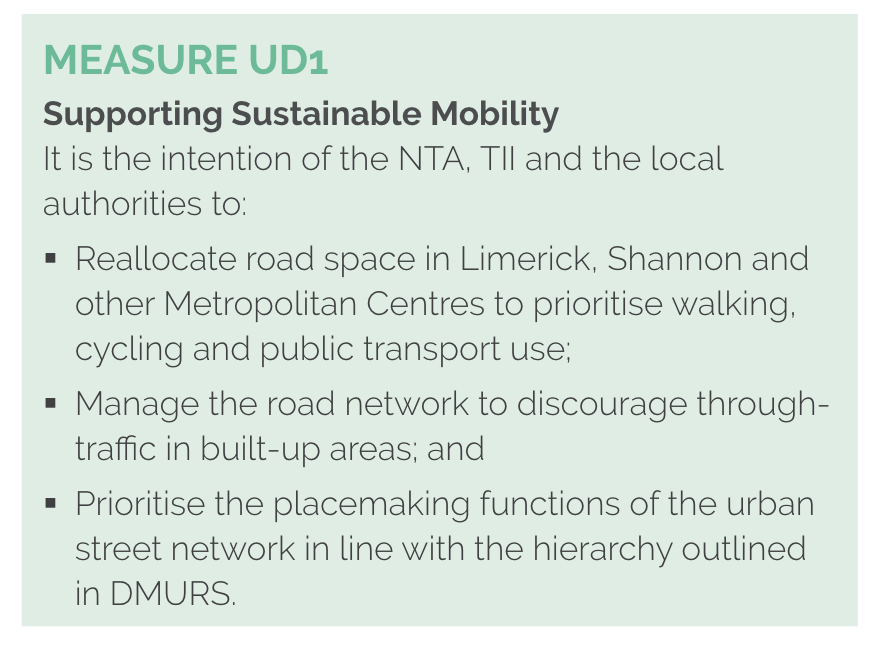
Climate and Carbon Reduction
The sectoral emissions ceilings for Transport in Ireland is a reduction of 50% or 6 MtCO2eq by 2030. Such a radical transformation cannot occur by poor quality cycle provision and cycling on car dominated roads Thus the goal of reducing CO2 should be clearly stated in the objective of the project.
Funding
The Sustainable Transport Measures Grant (STMG) the funding source for this project identifies its aim as follows
The STMG programme aims to improve transport options for those choosing alternatives to the private car. Available here
These points do not align with the project objective of improving comfort for motorists.
It is our suggestion to update this objective as follows
- Promote modal shift from private vehicle to more sustainable modes including walking, cycling and public transport;
- To provide continuous, high-quality and consistent cycling and walking facilities;
- To improve safety, comfort and security for cyclists and pedestrians.
Sustainable transport schemes should also enhance the communities they connect,
- To provide improved public realm areas and enhance the overall visual quality
- Enhance sustainable transport permeability
- Create places and infrastructure for all ages and abilities
These suggested objectives are informed by a similar Part 8 Scheme currently presented by Dún Laoghaire-Rathdown County Council under the same funding source and are available here on page 6.
3. Consideration should be given to bi-directional cycle tracks as they offer a better level of service to cyclists and micro-mobility.
Bi-directional physically separated cycle tracks that allow bicycle movement in both directions on one side of the road.
Bi-directional cycleways are becoming increasingly common as they facilitate social side by side cycling, overtaking, and more comfortable experience when sharing a space with micro-mobility devices that may be operating at different speeds.
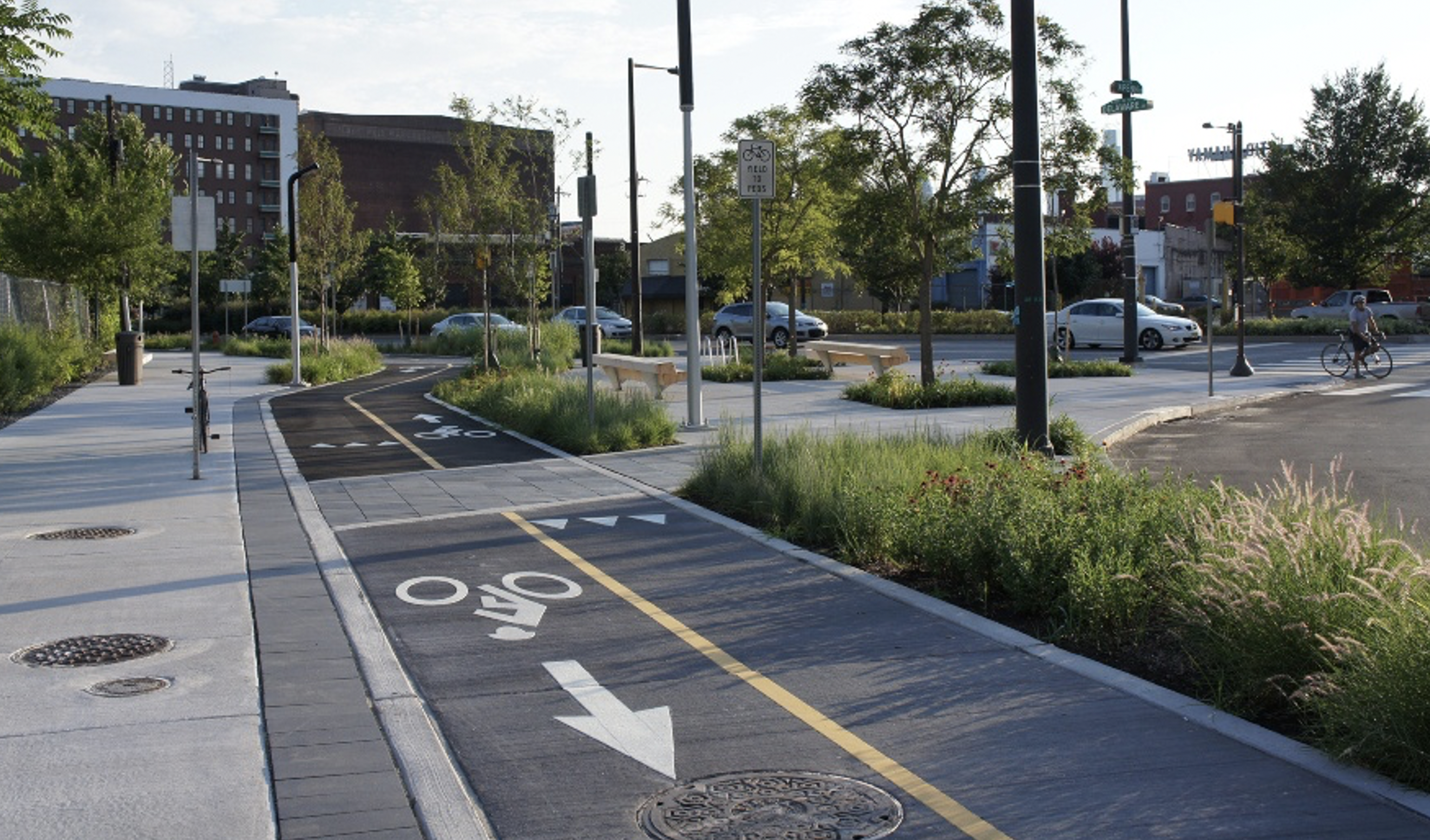
Example of a bi-directional cycle track
Example of a bi-directional cycle track
Bi-directional cycle tracks are considered a good idea when there are only a few end-destinations on one side of the street and when junctions can be planned in such a way they can offer a safe crossing at key intersections. These characteristics would deem them suitable for this scheme.
The options report presented as part of the part 8 documentation references a bi-directional option however it was dismissed due to the high number of crossing points (junctions and businesses) not supporting a 2-way option. This points to the comfort of cyclists and best practice ideals being ranked lower on the scale of priorities than the comfort of motorists and ensuring they are not inconvenienced.
The drawings presented show a cycle track width of 1.75m, and this gets narrower at certain points.
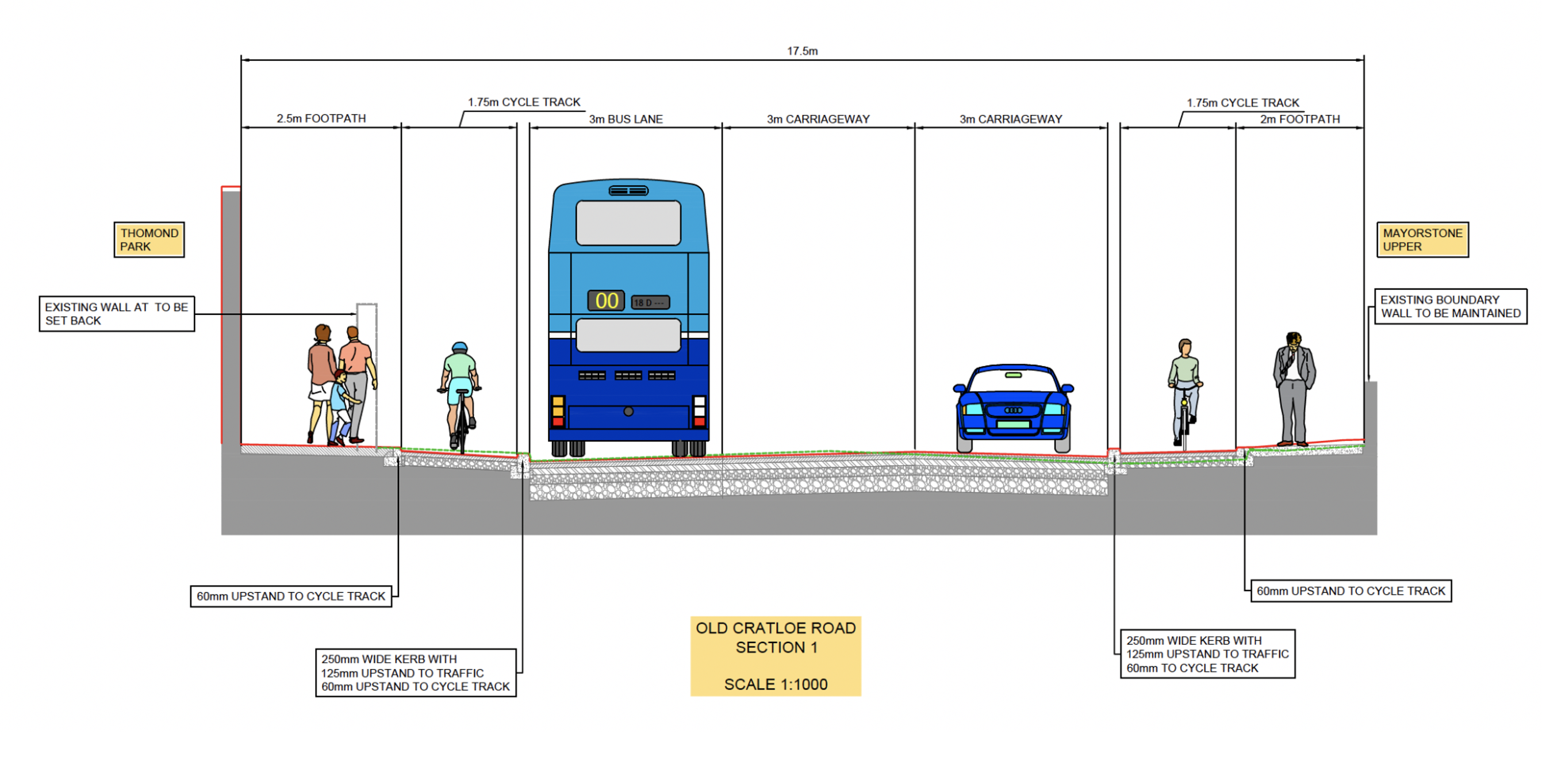
profile drawing from TUS to City Centre Scheme
According to guidelines set out in the National Cycle Manual, to allow for single file + overtaking the lane would need to be 2000mm at a minimum (inside edge: 250mm, cycling regime: 1250mm, outside edge: 500mm).
This places the proposed solution at the lowest end of a quality of a service ranking.
Considering that this scheme is a key arterial route that will service a third level institution and a number of primary and secondary schools and be the main sustainable transport corridor for the communities of Moyross, Cratloe Road, Caherdavin, Ballynanty, Mayorstone and Thomondgate we should be aiming for a higher quality of service.
The ability for people to be able to cycle safely and comfortably two abreast is critical to the success of any cycle route and especially those that service primary schools where parents are likely to cycle with their children. The first two lines in the NCM are as follows:
‘The “cycling offer” within urban areas must be improved to encourage more people to cycle, including those who are risk-averse. The goal is now to “raise the bar” and to aim to provide for two-abreast cycling in a stress free and safe environment.’
Section 4.1.5 of the NCM on ‘The need to Confer Advantage on the Bicycle’ states:
‘Key advantages that can be conferred include Pleasant and popular routes to encounter / talk to other cyclists, cycle two-abreast, take exercise’
The first key objective on the design of cycle links in Section 4.2 is as follows:
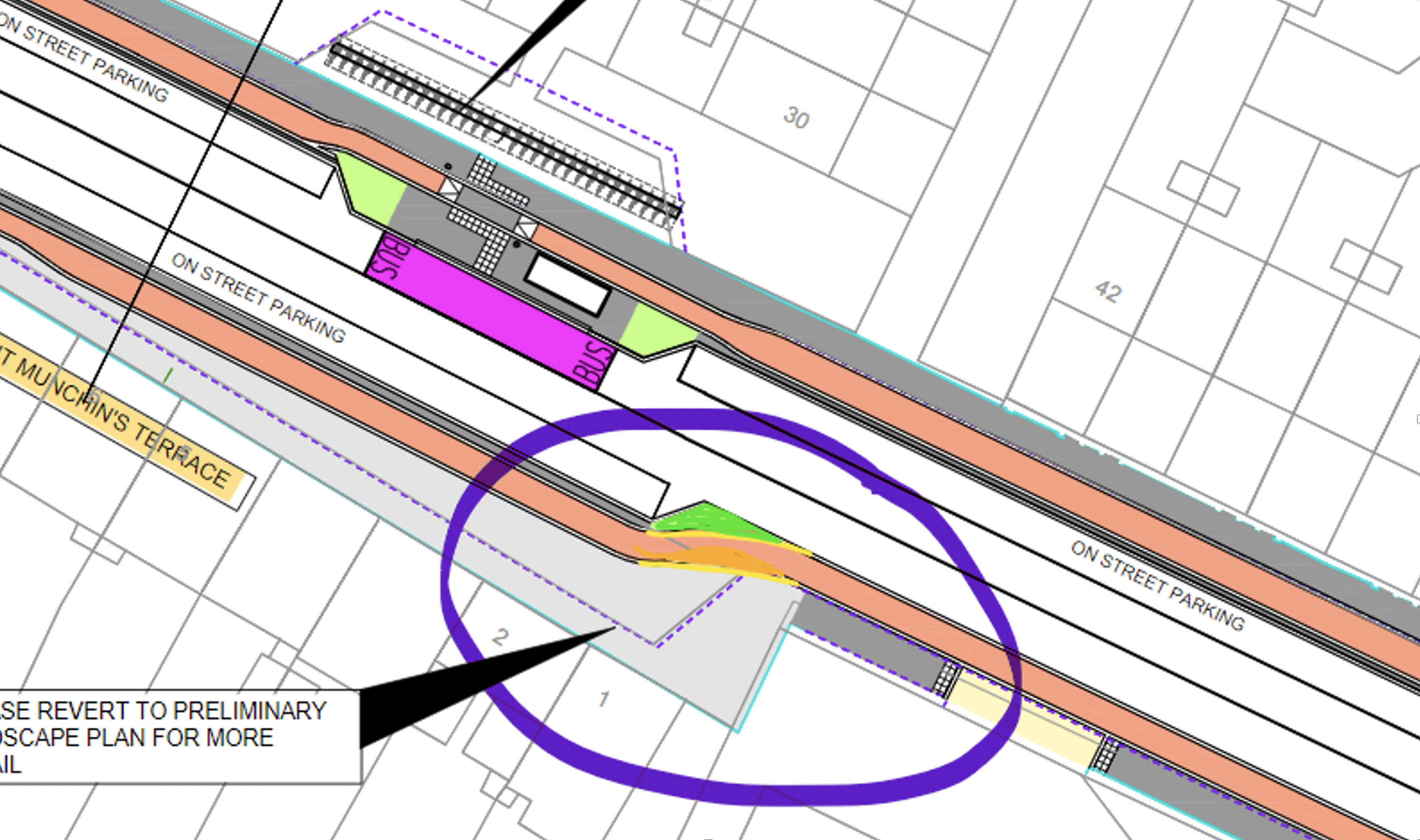
‘Providing two abreast where possible – this makes cycling more enjoyable, but the wider cycle facility also makes it safer, more visible and more attractive.’
Unnecessarily severe changes in direction reduce the comfort and safety of cyclists and should be avoided.
“The scheme will include segregated cycle tracks (nominally 1.75m) The national cycle manual states that The goal is now to “raise the bar” and to aim to provide for two-abreast cycling in a stress-free and safe environment.
The NCM states in section 1.5 “a substandard cycle lane is never recommended”.
An inner kerb and an outer kerb together require 1m buffer space. Additional space is required for uphill’s (such as from Hassets cross to city centre) and at junctions. 1.75 m wide lanes only allow for single file cycling. This is a low QOS. The NCM further advises in section 4.1.5 that;
It is unlikely that a significant increase in cycling will be achieved, if the Quality of Service offered to the bicycle is low.
Therefore, it is not acceptable in 2022, 11 years after the NCM was first published, to continue proposing and building cycling infrastructure that very few people will consider attractive or comfortable enough to consider making short car journeys by bike instead. This route is also meant to be a primary cycle network corridor – a primary network corridor should at a minimum cater for two-abreast cycling when physically possible.
4. A full solution should be included for the Moylish roundabout to complete the scheme
The proposed solution at the Moylish roundabout is not sufficient to serve cyclists in accessing Brookeville Avenue, the Old Cratloe Road or The Technological University of the Shannon (TUS) and the adjoining bike share station. It is unrealistic to expect cyclists to dismount and cross the pedestrian crossing before joining the short section of cycle track to enter TUS. This poor level of service and the ambiguity around the proposed design here will lead to continued unnecessary conflict between motorists, pedestrians and cyclists at this busy junction and serious safety concerns persist.
The full completion of cycling infrastructure orbiting the roundabout must be prioritised as a key aspect of delivering this project.
Without the full orbit of the roundabout being completed it will be a barrier to completing the other spurs of the cycle network that are identified in LSMATS for delivery.
It is our recommendation that a Dutch style roundabout should be included here as part of this scheme. This will bring significant value to the surrounding communities, and the primary, secondary and third level educational institutions it serves.
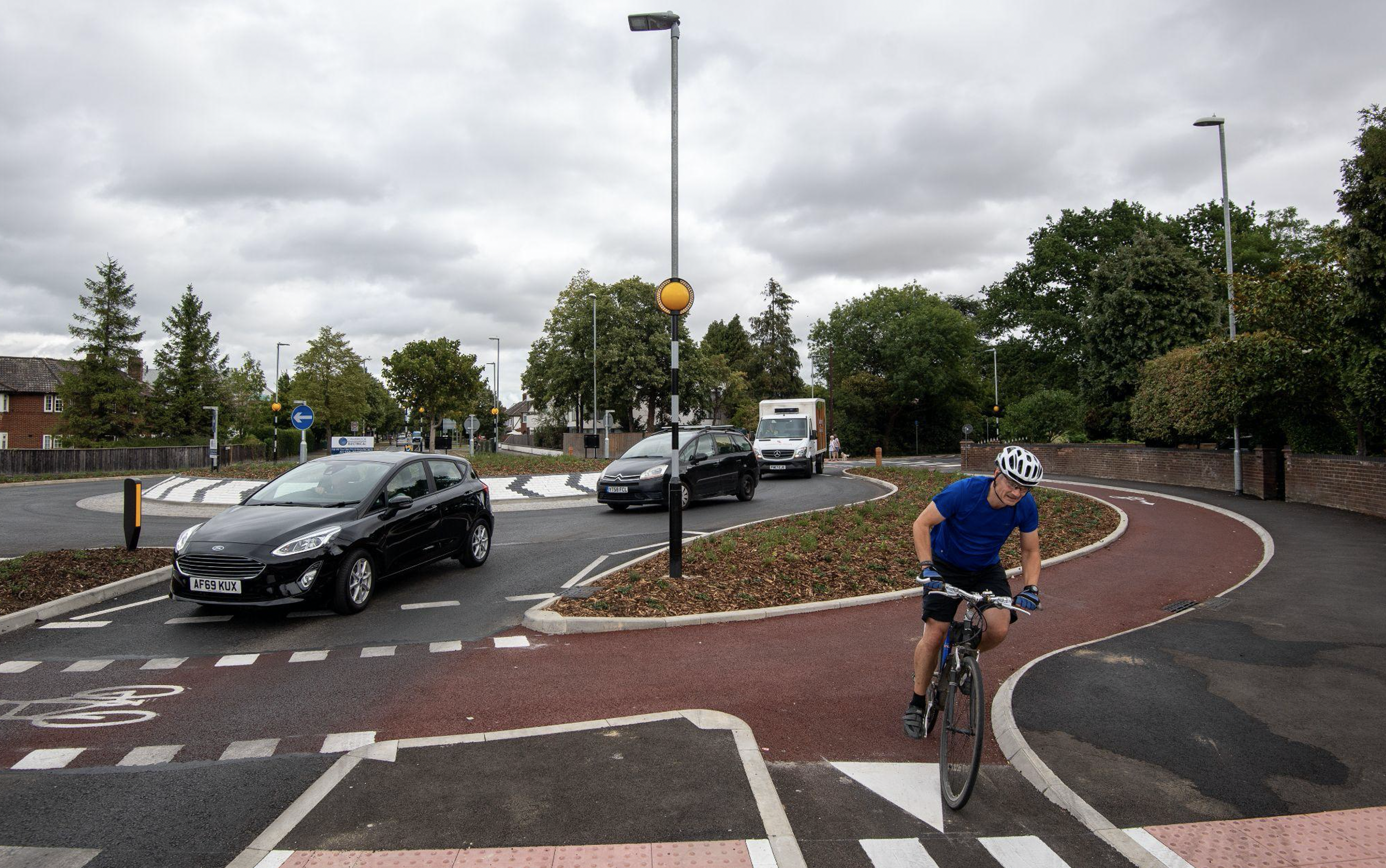
Example of a Dutch style roundabout in Cambridge England.
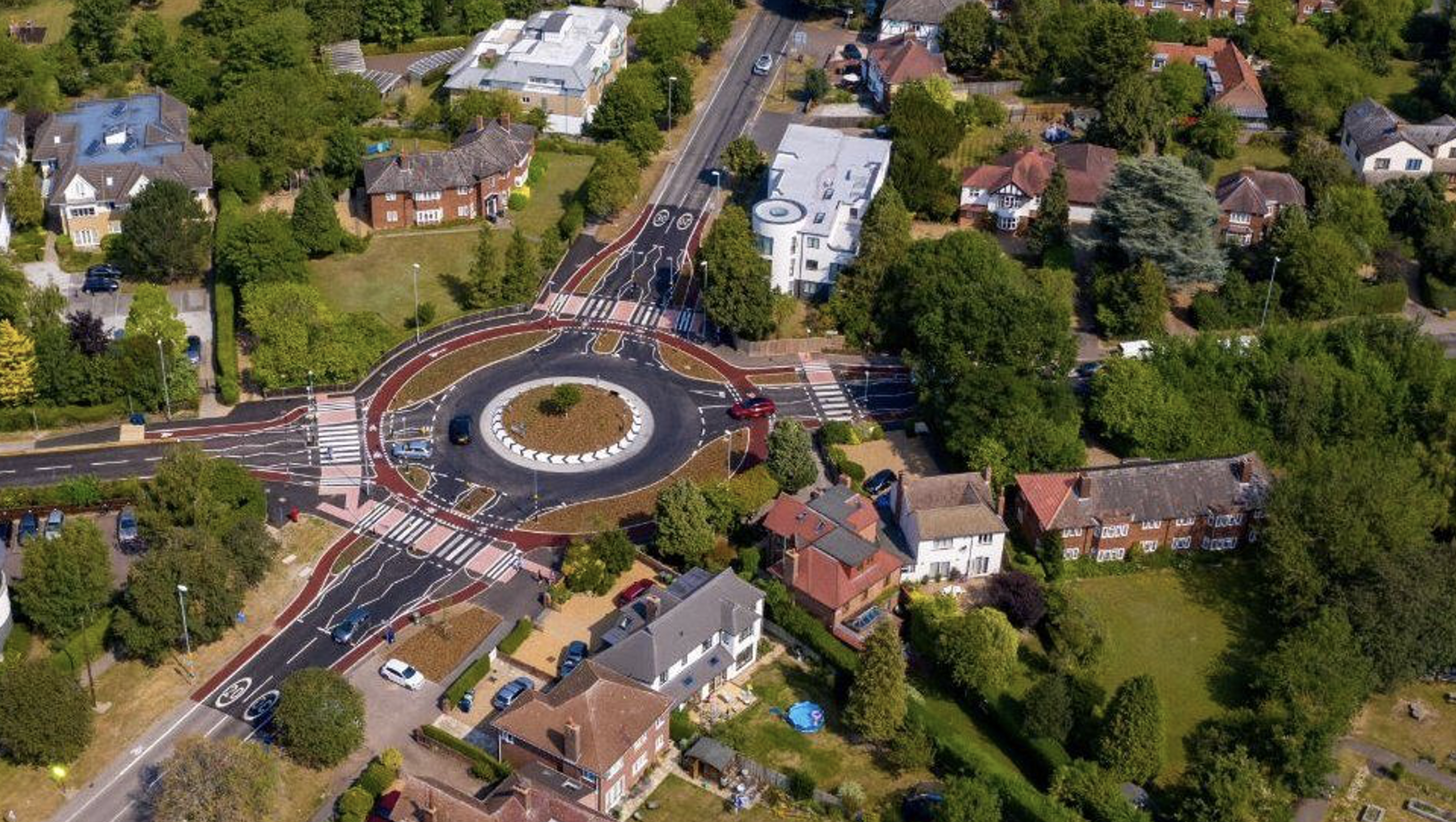
Example of a Dutch style roundabout in Cambridge England.
5. Socioeconomic objectives contained in LSMATS and Design Guide and Manual for the Regeneration Areas are not given due consideration or included in the project objectives
Social Inclusion
The importance of this route cannot be overstated; it not only provides a safe route for students attending TUS from all corners of the city but it also provides a route for communities on the northside of the city that are currently categorised as physically, economically and socially isolated from the city centre. It also provides a route for people attending or working in the University Maternity Hospital.
Inclusive transport projects improve opportunities for all by making it simple to reach destinations that count – jobs, schools, hospitals, shops, friends, green spaces. Ideally this project should contain specific indicators to measure how this route will contribute to promoting better access to opportunities, particularly for the most vulnerable segments of the population. The Limerick Cycling Campaign urge the local authority to consider that an opportunity exists within the realm of this project to promote better accessibility within the neighbourhoods of Moyross and Ballynanty.
One of the main findings of Limerick City and County Council’s document ‘Design and Public Realm Code for the Limerick Regeneration Areas 2015’ was that Moyross suffered from an over-provision of under-utilised public space. A fully connected route provides an opportunity to provide a pedestrian / cycle green route linking TUS to Ballynanty to Moyross, the Cratloe Rd and Sarsfield Gardens – a recommendation of the Design and Public Realm Code.
There is an opportunity too for this new route to link in with new sections of road connected to the NDR, which will incorporate off road cycle paths and footpaths – also a recommendation of the Design and Public Realm Code.
To ensure the viability of local authority commitments made to regeneration communities, as identified in 2015, projects such as TUS to City Centre should include stated aims detailing how connectivity and accessibility will be achieved in Moyross and Ballynanty and how this route will contribute to reversing the ‘physical, economic and social isolation’ that it identified in the area 7 years ago.
Home Zones
The Design and Public Realm Code makes reference to residential streets (e.g., Bellefield Gardens) where the road space is shared between drivers and other road users and the residents of the area including pedestrians, cyclists and children. These are referred to as home zones.
The aim is to change the way that streets are used and to improve the quality of life in residential streets by making them places for people, not just for traffic.
Limerick City and County Council list the 15 principles of designing ‘home zones’, including;
- maintaining a maximum speed of 30kmph with a view to encouraging lower speeds of 10kmph; more trees and planting defining the spaces;
- shared surface widths;
- universal access;
- spaces for sitting, resting, talking;
- safety for children to cycle, skate, scoot and play;
- pedestrian only routes.
We therefore urge that if the decision is taken to proceed with a ‘shared space’ in Bellefield Gardens (which is not optimising the potential of this section of the route), the above conditions are fully met to maximise safety when all road users must share the space without segregation or without additional safety infrastructure. The current design simply refers to Bellefield Gardens as ‘an upgraded shared surface with traffic calming features such as raised tables and chicanes to improve the route for cyclists’. We urge that more ambition is demonstrated to align this section of route with the principles of a home zone.
Public Health
Transport planning has undergone a marked change over the last twenty years and new paradigms that inform projects such as TUS to City Centre should include a much wider range of impacts and options. The research evaluates transport system performance on the basis of accessibility rather than just mobility and tends to support more integrated and multimodal planning. This new and progressive way of designing city transport systems, supports and is supported by comprehensive health impact analysis.
Therefore, the Limerick Cycling Campaign urge the local authority to conduct a Health Impact Assessment on the preferred route – particularly the Bellefield Gardens section of the route as it is a residential street accommodating a maternity hospital and experiences significant congestion each morning from 8am -9am and take note of Measure UD1 and UD2 in LSMATS;
‘There has been a step-change in recent years to re-examine the role our streets play as places that support a much broader range of functions. This shift in focus is in-line with recognition of the impacts that congestion and emissions have on the environment and people’s quality of life’.
‘Better street design in urban areas will encourage more people to choose to walk, cycle or use public transport by making the overall experience more safe, accessible and attractive. It will lower traffic speeds, reduce unnecessary car use and create a built environment that responds more sympathetically to the distinctive natures of the individual communities and places across the LSMA’.
The global prevalence, morbidity and mortality related to childhood asthma has increased significantly over the last 40 years and asthma is recognized as the most common chronic disease in children. The evidence tells us that children exposed to higher levels of PM2.5 are more likely to develop asthma and persistent wheezing than children who are not exposed. There is a direct link between TRAP and early onset of paediatric asthma.
Unfortunately, Ireland currently ranks fourth globally in terms of prevalence of asthma and according to the Irish Cancer Society, Limerick has the highest rates. Therefore, it is imperative that new transport projects, such as TUS to City Centre take these statistics into account when redesigning roads in built-up residential areas, directly outside hospitals, in particular maternity and paediatric hospitals and clinics.
All new transport projects should incorporate public health objectives into the overall project objectives to ensure that transport decisions are not negatively impacting the health of citizens.
Limerick Cycle Bus
Many of the families that use the cycle bus to travel from the northside of the city to two city centre schools each morning, use Bellefield Gardens to connect with the wider group.
Approximately 15-20 children use the Bellefield Gardens route each morning and afternoon travelling to and from school, a route that they consider unsafe due to the volume and speed of car traffic that use it at these peak times.
The cycle bus has grown in numbers from 2-3 families in 2019 to 30+ families currently and therefore as per MEASURE LU13 of LSMATS V2, the cycle bus community in Limerick urge the local authority to take this feedback into account when making decisions around infrastructural investment. If it is the intention of the NTA and the local authorities to continue to foster a cycling culture in the LSMA through behavioural change initiatives such as the cycle bus (as referenced in LSMATS), then the Bellefield Gardens section of this route needs to be revisited.
Conclusion
The TUS Moylish to City Active Travel Scheme is the first large-scale primary active travel route provided under the newly formed Active Travel Office. With other key arterial routes to be delivered in City East and City West in the near future it is essential we hit the highest standards possible in the first arterial route project. The project shows a significant improvement in approach, design and mindset from projects that were delivered before the founding of the Active Travel Office and we are very grateful for the positive moves shown in the document.
However, after spending considerable time reviewing the planned design of this Part 8, including reviewing the options report which is 7 years old and falls short of the objectives contained in the proposed outcomes of the funding source, LSMATS and national policy, Limerick Cycling Campaign urges the local authority to revisit this design to ensure there is full segregation from the starting point to the end point.
We hope that our observations have been helpful and constructive to the design team and the Active Travel Office and as always, we are available for any further input or consultation as a key stakeholder in making Limerick a safe, connected, enjoyable city for cycling.
As identified in LSMATS – (the strategy) “is underpinned by the ongoing work of the NTA’s commitment to sustained engagement with representative groups throughout the implementation of its plans and programmes. This engagement with local communities and other stakeholders will help achieve the most equitable outcomes for all”.
Limerick Cycling Campaign
September 2022
Make your own Submission
Please consider making a submission, it’s easy
You can make your submission online here
Submissions must be received on or before 4 pm on Wednesday 14th September 2022.
